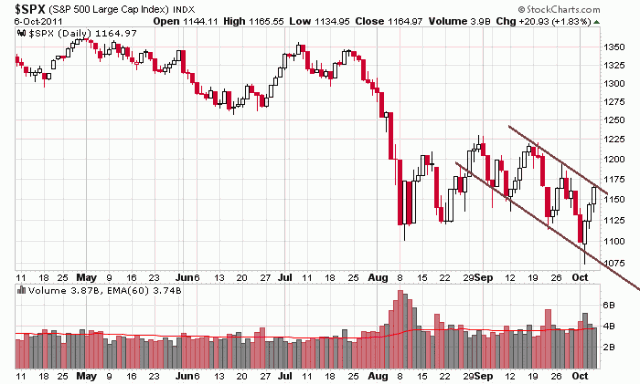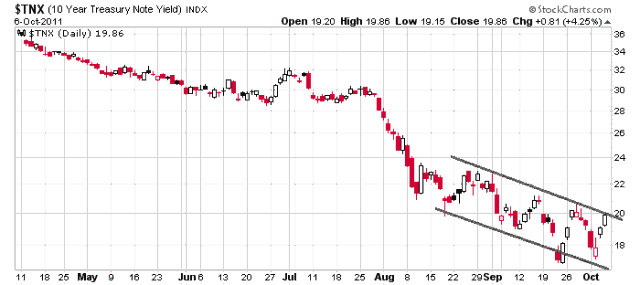Petrobakken (TSX: PBN) gave a quarterly status update with respect to its production and indeed, it is around what it stated (43,000 barrels of oil equivalent per day).
Most interestingly is the paragraphs they devoted towards recent speculation concerning their debt levels, with me bold-facing some of the quoted material below for emphasis:
At the end of September, PetroBakken had $1.14 billion drawn (essentially unchanged from the end of June 2011) on our three year, $1.35 billion credit facility, leaving us with over $200 million of credit capacity available on the current line in addition to our growing cash flow. Recently, there has been some market focus on our convertible debentures which mature in February 2016. The debentures have a one-time, one-day early put option on February 8, 2013 that allows those holders that elect to exercise the option to request payment in full for their debentures. In the event that holders request payment, PetroBakken has the option to repay in cash or through the issuance of PetroBakken shares based on the then current share price.
The Company has been, and will continue to be, pursuing various options to provide additional flexibility in order to repay any bonds that may be put back to us with either cash or shares. In addition to our growing production base and the potential for increasing cash flow over time, those options include: modifying our capital program and/or altering our dividend to provide additional free cash flow; issuing additional debt instruments; instituting a dividend reinvestment program; renegotiating the terms of the existing convertible debentures; or realizing on asset sales. Early in the second quarter of 2011, the Company engaged TD Securities Inc. as financial advisor, to assist the Company in our assessment and pursuit of certain options to provide increased liquidity, and we continue to actively evaluate alternatives going forward. Further announcements on the progress of this process will be made at the appropriate time.
We have positioned our asset base to focus on value creation for our shareholders, and decisions on how best to manage the business are made with both a short term and long term strategic outlook in mind. PetroBakken has built a strong portfolio of assets with a multi-year inventory of light oil drilling locations from which we can generate accretive, long term, growth. This portfolio includes over 440,000 net acres with over 1,400 net drilling locations in the well established Bakken and Cardium light oil resource plays; more than 480,000 net undeveloped acres and 300 light oil net drilling locations for conventional opportunities in southeast Saskatchewan; over 120,000 net undeveloped acres on new potential light oil resource plays (many that have seen significant attention by the industry in recent land sales); and a material land position in northeast British Columbia for future natural gas opportunities. With this asset base, and based on our current activity plans, we intend to deliver year-end 2011 production of 46,000 to 49,000 boepd. At the mid-point of this range, and based on US$85 WTI per barrel, we would expect to generate annualized cash flow of approximately $850 million. With expected continued growth in production in 2012, we would anticipate funds flow from operations (based on a similar WTI price) to grow further to equal or exceed our total capital expenditures and dividend payments. However, if conditions change, we will not hesitate to evaluate the other alternatives available to us, including altering our dividend and/or capital spending levels.
Current economic conditions and market rumours have caused shareholder focus to be turned away from the high quality, light oil assets that underpin the Company, to the perceived strength of our balance sheet in light of the convertible debenture put date (that is 16 months away) and our current capital and dividend plans. We are aware of the concern over our debt position and, as outlined above, we have several options at our disposal which we are actively assessing to effectively manage this situation in varying commodity price environments while continuing to pursue our strategies for long term, accretive, growth.
Some notes that went through my head:
1. The company’s current market capitalization is CAD$1.26 billion; the amount of the convertible note is US$750M. At present prices a share conversion would result in a 38% dilution of shareholder interest in the company. In addition, the additional amount of shares would virtually guarantee a dividend decrease (the convertible note’s coupon is 3.125%).
2. How much in capital expenditures does it take to sustain a production level at 43,000 boepd, or even to expand it to 46,000-49,000 boepd? If the company decided to pare back capital expenditures, how fast would production decrease? The large problem with the wells the company is producing is that the majority of oil obtained comes from the first year – production tapers off rapidly from the initial production.
3. Is WTIC at US$85 a valid assumption? Obviously this is something the company can’t control but is an obvious factor in the market price. At 47,500 boepd, WTIC at US$85 for CAD$850M operating cash flow will drop significantly as WTIC goes lower (more than a CAD$10M decrease to a US$1 drop in WTIC!). The operating cash flow is ultimately an incomplete figure since it goes back to question #2 where you have to ask yourself how much in capital expenditures will it take to actually keep production at that level. However, they do have 8000 boepd (roughly 17% of expected production) hedged with an average floor of US$76.09 WTIC in the year 2012. This still will not protect them from more significant decreases in oil prices.
I still believe Petrobakken equity is trading above fair value. They will be going through a painful de-leveraging as they figure out how to cough up US$750 million in 16 months.

